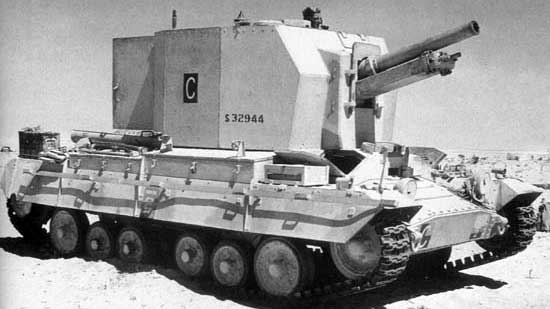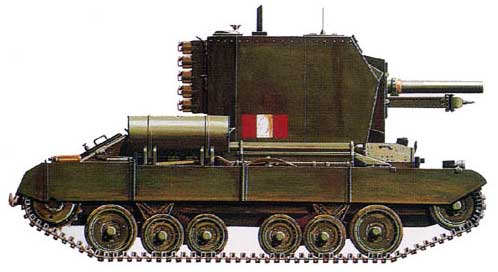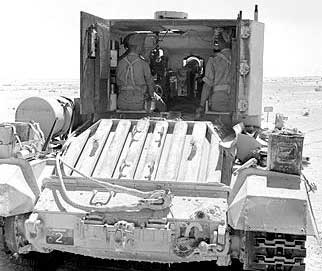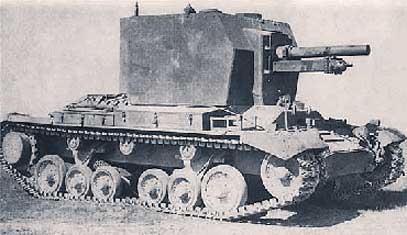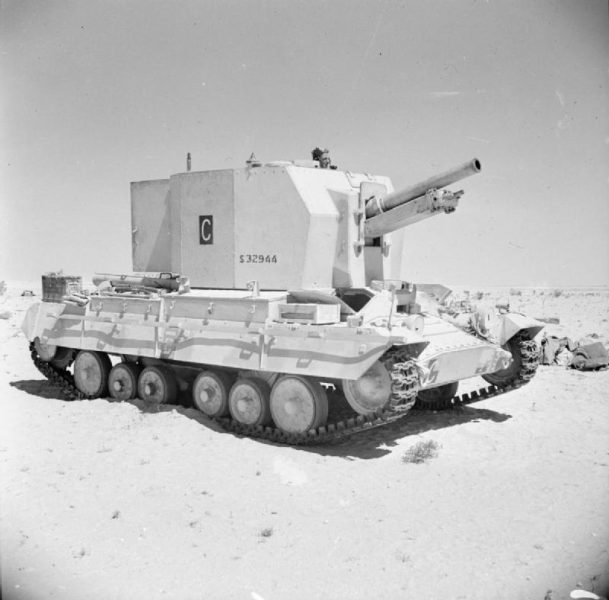
Self-propelled artillery installation Bishop
Self-propelled artillery installation BishopOrdnance QF 25-pdr on Carrier Valentine 25-pdr Mk 1,
The maximum firing range of a high-explosive fragmentation projectile weighing 11,34 kg is 8000 m. Carried ammunition is 49 shells. In addition, 32 shells can be placed on a trailer. To control fire on a self-propelled unit, there is a tank telescopic and artillery panoramic sights. The fire can be conducted both by direct fire and from closed positions. Bishop self-propelled guns were used in the artillery regiments of armored divisions, but during the war they were replaced by Sexton self-propelled guns.
The agile nature of the fighting in North Africa led to the order of a self-propelled howitzer armed with a 25-pound QF 25 pounder gun. In June 1941, development was assigned to the Birmingham Railway Carriage and Wagon Company. The self-propelled gun built there received the official designation Ordnance QF 25-pdr on Carrier Valentine 25-pdr Mk 1, but became better known as Bishop.
The Bishop was based on the hull of the Valentine II tank. In the base vehicle, the turret was replaced with a non-rotating box-type cabin with large doors at the rear. This superstructure housed a 25-pound howitzer cannon. As a result of this placement of the main armament, the vehicle turned out to be very high. The maximum elevation angle of the gun was only 15 °, which made it possible to fire at a maximum distance of 5800 m (which was almost half the maximum range of fire of the same 25-pounder in the towed version). The minimum declination angle was 5 °, and the aiming in the horizontal plane was limited to a sector of 8 °. In addition to the main armament, the vehicle could be equipped with a 7,7 mm Bren machine gun.
The initial order was given for 100 self-propelled guns, which were delivered to the troops in 1942. Another 50 vehicles were subsequently ordered, but according to some reports, the order was not completed. The Bishop first saw combat during the Second Battle of El Alamein in North Africa and was still in service during the initial phase of the Italian campaign of the Western Allies. Due to the limitations mentioned above, coupled with the slow speed of the Valentine, the Bishop was almost always judged to be an underdeveloped machine. In order to somehow improve the insufficient firing range, the crews often built large embankments inclined to the horizon - Bishop, driving onto such an embankment, acquired an additional elevation angle. The Bishop was replaced by the M7 Priest and Sexton self-propelled guns as soon as the numbers of the latter allowed for such a replacement.
Performance characteristics
Sources:
|

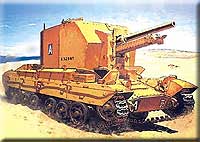 The Bishop self-propelled gun has been manufactured since 1943 on the basis of the Valentine light infantry tank. Instead of a turret, a bulky rectangular fully enclosed conning tower with an 87,6-mm howitzer-cannon was mounted on the remaining practically unchanged chassis of the tank. The conning tower has relatively strong combat protection: the thickness of the front plate is 50,8 mm, the side plates are 25,4 mm, the thickness of the roof armor plate is 12,7 mm. A howitzer mounted in the wheelhouse - a cannon with a rate of fire of 5 rounds per minute has a horizontal pointing angle of about 15 degrees, an elevation angle of +15 degrees and a descent angle of -7 degrees.
The Bishop self-propelled gun has been manufactured since 1943 on the basis of the Valentine light infantry tank. Instead of a turret, a bulky rectangular fully enclosed conning tower with an 87,6-mm howitzer-cannon was mounted on the remaining practically unchanged chassis of the tank. The conning tower has relatively strong combat protection: the thickness of the front plate is 50,8 mm, the side plates are 25,4 mm, the thickness of the roof armor plate is 12,7 mm. A howitzer mounted in the wheelhouse - a cannon with a rate of fire of 5 rounds per minute has a horizontal pointing angle of about 15 degrees, an elevation angle of +15 degrees and a descent angle of -7 degrees.
